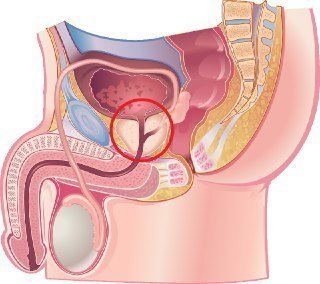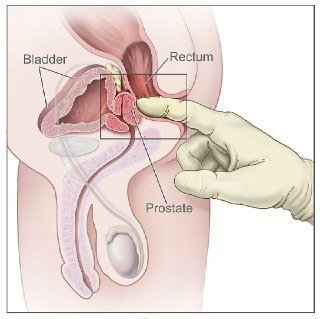Guard Prostate
The word prostate comes from the word "prostates", which is derived from a Greek word. Its meaning is standing in front, guard and protector. The size of a normal prostate in a healthy male is as a large walnut. The weight of the prostate is between 10 and 20 grams. It is located at the base of the urinary bladder and it also surrounds the urinary tract.

Figure 1:
Anatomical structure of the prostate

Figure
2: The digital examination of the prostate (rectal examination).
It protects the urinary tract and sperm pathway from many infective agents until the end of middle ages in males. It protects the sperm (male germ cell), which is the reproductive cell in males in a male with reproductive function, from environmental factors and provides optimal conditions for fertilization. It protects the sperm from the acidic environment in the vagina by making the environment that the sperm is in alkaline and cause it to live longer.
The prostate remains stable after birth and reaches to its normal size at the age of 20 by growing through the change of the hormonal structure at puberty. The prostate remains in normal size from the age of 20 until the age of 40, and begins to grow again after the age of 40. This second growth, which is unwanted, occurs with the contribution of the changing hormonal structure and genetic infrastructure.
Prostate diseases, which are the most common group of diseases in males in the world, is observed more as prostate infections in young ages, while encountered more as benign prostatic hyperplasia (BPH) or prostate cancer (PCa) after the ages of 50.
We started to observe BPH and especially prostate cancer more often with the rapidly aging of the population. Prostate cancer is currently the most common cancer in males and ranks second in the death rankings behind lung cancer. Thus, it is becoming a quite important social and medical problem in the aging society. Urination problems that affect the quality of life begin in almost half of the males after the age of 50.
Benign Prostatic Hyperplasia (BPH):
Advancing age and the presence of functional testes are the most effective factors identified for benign prostatic hyperplasia. As can be understood from this sentence, as the world's population ages, the number of people that need treatment because of prostate diseases will also increase. Benign prostatic hyperplasia is present at the cellular level in 75% of 80-year-old males.
Lower urinary tract complaints can be listed as hesitation in passing to urination action, intermittent urination, dripping after urination action is over, urination with split stream, straining to urinate, prolongation of urination time, increase in the daily frequency of urination, need for urgent urination, urinary incontinence associated with the need for urgent urination, waking up with the need for urination at night, painful urination and urinary incontinence. These complaints may be a symptom of BPH that causes obstruction in the urinary bladder output.
There are a lot of treatment alternatives for BPH, which can be diagnosed with a simple prostate check-up. Such as regulation of lifestyle, medication treatment, green light laser therapy.
Prostate Cancer (PCa):
Prostate cancer is also an issue that needs to be emphasized when speaking on prostate diseases. Prostate cancer is the most common type of cancer in males in the world. The risk of getting prostate cancer of a male over the lifetime is 15%, and the risk of death due to this is 2.9%. Risk factors can include family history, western-style diet, and the black race.
Prostate specific antigen (PSA) is the parameter that we use most frequently for the diagnosis of prostate diseases. PSA, which is a protein produced only by the prostate in the body, increases during prostate diseases by passing to the blood. Thus, any distortion that may occur in the prostate tissue leads to PSA increase. These include inflammation of the prostate, prostate cancer and benign prostatic hyperplasia.
Early diagnosis is gaining importance in this disease, in which the chance of treatment and becoming disease-free is high while confined in the prostate. Prostate examination and measurement of blood PSA level once in a year after the age of 40 in those with a family history and after the age of 50 even though no complaint is present may be sufficient for early diagnosis. The digital examination of the prostate (rectal examination) is an alone diagnostic examination independent of the PSA values. This irritating examination method allowing direct access to the prostate, which is a hidden organ, is a screening method especially needed for prostate cancer (Figure 2).
Increase in life expectancy and significant decreases in the clinical stages of the patients is now started to be observed based on developments in the treatment of prostate cancer in the recent years. In particular, thanks to both surgical and radiotherapy facilities to be applied in the early stages of prostate cancer, the patients can get rid of the cancer completely.

 TOBB ETÜ HASTANESİ TIP FAKÜLTESİ
TOBB ETÜ HASTANESİ TIP FAKÜLTESİ
Loading...